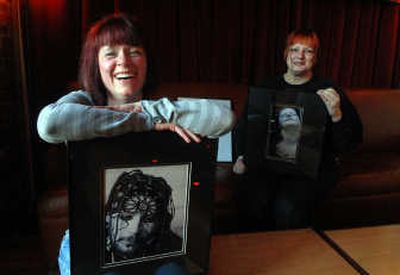Photographer wants to raise awareness of city’s ‘invisibles’

Bethany Mahan likes hanging out in tattoo parlors, alleyways and what she calls “imperfect places.”
She has no fear. “People are people,” she said. She goes out several times a week and talks to the pierced, the tattooed, the homeless, the addicts and the runaways, and she captures their plights with her camera.
Mahan, 37, was diagnosed with adult attention deficit disorder a year and a half ago and began taking medication. “Now I think more clearly,” she said, “I’ve always been creative but I didn’t know how to release it. Now I feel more genuine and authentic. I’m not afraid anymore.”
She picked up a camera a year ago and has rarely put it down. While working at A Cup of Cool Water, a safe haven for the homeless in downtown Spokane, she was inspired to take her first photograph of a 19-year-old girl with a Mohawk who had been homeless for years. The piece, “Straight Talk of Street Rats and Whores,” is in black and white and reflects the girl’s strength and fragility.
In Mahan’s artist’s statement she writes, “I love anything beautiful found in: the ugly and mundane, forgotten, sneered at, turned away from or typically missed …” and her camera doesn’t miss a thing, especially the beauty within. Deep wrinkles, scars, dirty nails, someone puffing on a marijuana pipe, another enjoying a cigarette, others surviving, existing and doing the best they can are captured in such a way that they look beautiful.
Mahan points out one photo of a woman praying, suffering with skin cancer, no eyebrows or lashes and adorned with a necklace of skulls. “She looks enraptured in the midst of her darkness,” Mahan said.
Using a photo-editing computer program, Mahan often removes color from her work. “Color distracts from the energy and emotion,” she said, “Changing it to black and white takes out the noise and makes it speak.” It also gives new life to flowers and nature scenes.
Mahan’s work speaks volumes and gives voice to what she calls the “marginals” of our community adding that, “we’re all marginalized in one way or another.”
Mahan admits that she sees herself in many of her subjects and thinks that everyone at one time or another has felt invisible. Also a poet, Mahan’s poem, “Image of God,” urges others to “acknowledge feeling invisible,” “ponder your authenticity,” “consider your desires,” and “contemplate what it is to be human,” which Mahan does through her photographs.
Her goal is to raise awareness for the “forgottens” and “invisibles” of our city. She also wants to make a living by doing commercial and private jobs as a photographer. She is looking for places to show her work and is compiling pieces for a coffee-table book that she hopes will “spark a realization about how incredible each person is, regardless of race, religion or financial situation.” She said she will donate 50 percent of the book’s profits to local nonprofit organizations.
Mahan’s ultimate goal is to bring light and depth to what might initially appear two-dimensional. Her artist’s statement ends with: “After great darkness comes even greater light. And so goes the heart of man. I consider capturing these moments truly an honor.”